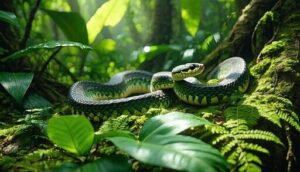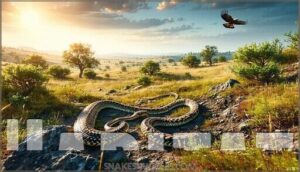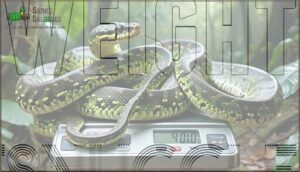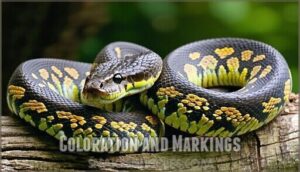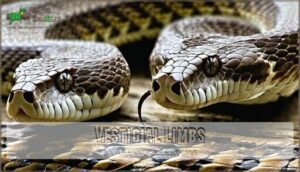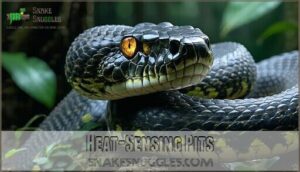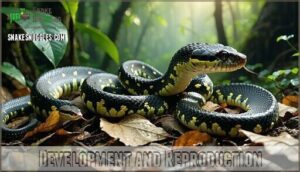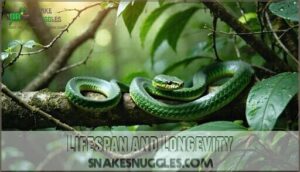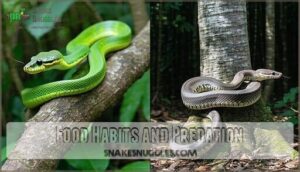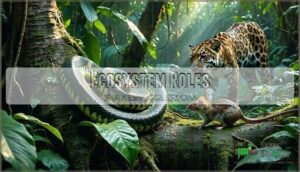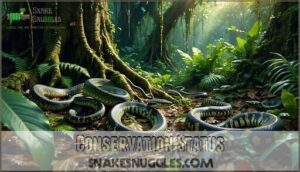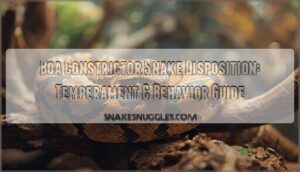This site is supported by our readers. We may earn a commission, at no cost to you, if you purchase through links.

These muscular giants can stretch their years to 20-30 in captivity, with proper care acting like a fountain of youth. The record holder? A snake named Popeye who lived an impressive 40 years, 3 months, and 14 days at the Philadelphia Zoo.
That’s like comparing a wild marathon runner to someone with a personal trainer and nutritionist. Your pet boa’s longevity depends on factors you can control, from diet quality to habitat conditions that most owners never consider, including the importance of a suitable environment for a long and healthy life, which can be achieved with proper habitat conditions and a good understanding of the snake’s needs, ultimately leading to a longer lifespan, similar to having a personal trainer and nutritionist.
Table Of Contents
- Key Takeaways
- Geographic Range
- Habitat
- Physical Description
- Development and Reproduction
- Lifespan and Longevity
- Behavior
- Food Habits and Predation
- Ecosystem Roles
- Economic Importance
- Conservation Status
- Frequently Asked Questions (FAQs)
- How long does a boa constrictor live in captivity?
- Is a boa constrictor a good pet?
- Do boa constrictors recognize their owners?
- What is the lifespan of a red tail boa constrictor?
- How long do boa constrictors live as pets?
- Do boa constrictors make good pets?
- How old is the oldest boa constrictor?
- Do boa constrictors like to be held?
- How does captivity affect a boa constrictors lifespan?
- Do male and female boa constrictors have different lifespans?
- Conclusion
Key Takeaways
- You’ll see your boa constrictor live 25-30 years in captivity versus just 7-12 years in the wild, with the oldest recorded reaching over 40 years at the Philadelphia Zoo.
- You can dramatically extend your boa’s lifespan through proper care, including consistent feeding, stable temperatures, appropriate humidity, and regular veterinary checkups.
- You won’t find significant lifespan differences between male and female boa constrictors, as both sexes live equally long when given proper care and environmental conditions.
- You’re making a serious long-term commitment since these snakes aren’t beginner pets and require decades of specialized care, making them unsuitable for inexperienced reptile keepers.
Geographic Range
The boa constrictor species claims one of nature’s most impressive territories across the Americas. You’ll encounter these adaptable giants from northern Mexico down to Argentina’s northern regions.
Their native habitat spans an enormous area that showcases remarkable genetic diversity across different populations.
Range factors play a vital role in their survival success. These snakes have mastered living everywhere from Caribbean islands like Trinidad and Tobago to mainland rainforests.
Distribution limits stretch across both Pacific coastal islands and Lesser Antilles locations including Dominica and St. Lucia.
What’s fascinating is how habitat variation influences their adaptability. Regional lifespan differences emerge based on local conditions and resources.
Introduced populations have even established themselves beyond their original range, proving their resilience. Black mambas, conversely, favor rocky savanna habitats.
Their habitat requirements are surprisingly flexible, allowing them to thrive in diverse environments. This extensive distribution makes boa constrictors true continental travelers, adapting to whatever Mother Nature throws their way across the New World.
Habitat
You’ll find these impressive snakes living in surprisingly diverse places throughout Central and South America, from dense rainforests to dry grasslands.
These adaptable giants have mastered every habitat from Caribbean islands to Argentine rainforests, proving they’re true continental travelers.
Their adaptable nature lets them thrive in hollow logs, abandoned burrows, and even areas near human settlements where they help control rodent populations, which is a key aspect of their presence in these diverse places.
Rainforest Clearings
When exploring tropical forests, you’ll discover boa constrictor lifespan thrives in rainforest clearings where sunlight penetration creates unique clearing microclimates.
These edge effects boost species diversity, providing abundant prey that supports boa constrictor longevity.
Young boas master canopy navigation while adults patrol ground level.
How long do boas live depends partly on these productive habitats, though conservation efforts fight ongoing habitat loss threatening their survival.
Woodlands and Grasslands
Beyond dense rainforest clearings, boa constrictors make themselves at home in woodlands and grasslands where open spaces meet scattered vegetation.
These diverse landscapes provide excellent prey availability with rodents, birds, and small mammals flourishing in mixed terrain. Camouflage adaptation works beautifully here – their mottled patterns blend seamlessly with dappled sunlight filtering through trees and tall grasses.
Seasonal changes affect boa constrictor habitat preferences, while fire effects occasionally reshape these ecosystems. Understanding this habitat impact helps explain boa constrictor lifespan patterns and informs proper boa constrictor care in captivity.
Given their reliance on these environments, understanding the importance of retreat sites for shelter is essential.
- Dappled sunlight creates perfect camouflage patterns through scattered tree canopies
- Tall prairie grasses sway gently, hiding coiled serpents waiting for unsuspecting prey
- Rocky outcrops provide thermal regulation spots where boas bask in morning warmth
Dry Tropical Forests
During the harsh dry season, boa constrictors master survival in dry tropical forests across tropical Central and South America.
These resilient giants adapt to water scarcity and seasonal changes through remarkable forest adaptations. Their cryptic patterns blend with sparse vegetation while they hunt for scarce prey.
| Adaptation Feature | Survival Benefit |
|---|---|
| Cryptic coloration | Camouflage in dry vegetation |
| Water conservation | Reduced metabolic needs |
| Flexible diet | Adapts to prey availability |
| Shelter seeking | Protection from heat |
| Reduced activity | Energy conservation |
Conservation efforts protect their boa constrictor habitat, ensuring healthy boa constrictor lifespan despite environmental challenges.
Semi-Deserts
You might be surprised to discover these giants making their home in semi-desert regions, where water scarcity and temperature extremes test their limits.
Arid adaptations help boa constrictors survive harsh conditions that would challenge most reptiles. Their boa constrictor lifespan actually benefits from consistent temperatures, though desert prey becomes scarce during dry seasons.
Conservation challenges increase as human development fragments these fragile ecosystems.
- Specialized scales minimize precious water loss in brutal heat
- Heat-sensing pits detect warm-blooded prey during cool desert nights
- Months-long fasting abilities sustain them through lean periods
- Camouflage patterns blend seamlessly with sandy, rocky terrain
- Resilient physiology maintains reptile longevity despite harsh conditions
Near Human Settlements
Boa constrictors show remarkable Urban Adaptation near human settlements, thriving in agricultural areas where rodents flourish.
Their adaptability in urban environments affects boa constrictor lifespan differently than wild vs captivity scenarios.
Pet Escapes create unexpected populations, while Human Interaction brings both benefits and risks.
| Challenge | Impact | Solution |
|---|---|---|
| Habitat Loss | Reduced lifespan | Conservation Challenges |
| Vehicle Strikes | Injury/death | Wildlife corridors |
| Conflict Mitigation | Human safety | Education programs |
| Pollution | Health issues | habitat protection |
Human expansion creates complex survival puzzles for these serpentine neighbors.
Supplying adequate boa enclosure products is essential for their well-being.
Physical Description
You’ll recognize a boa constrictor by its impressive size and striking patterns that make it look like nature’s own work of art.
These powerful snakes can reach up to 13 feet long and weigh as much as a medium-sized dog.
Their colorful markings help them blend into their surroundings.
Size and Length
Picture holding a snake that stretches longer than your car!
Imagine wrestling with a muscular rope that weighs as much as your golden retriever!
Boa constrictors reach impressive lengths of 6-13 feet, with sexual dimorphism making females noticeably larger than males.
Hatchling size starts at just 2 feet, but their growth rate stays steady throughout their boa constrictor lifespan.
Size variability depends on genetics and environment, creating fascinating adult size differences across populations.
Weight
These serpents are heavyweight champions in the snake world.
Adult weight typically ranges from 30 to 60 pounds, though some giants reach 100 pounds.
Juvenile weight starts around two pounds at birth, and weight maturity occurs by age three when growth slows.
Captive weight often exceeds wild specimens due to consistent feeding.
Watch for obesity risks from overfeeding—it’s surprisingly common in pet boas and affects their lifespan.
Coloration and Markings
Beyond their impressive weight, boa constrictor morphs display remarkable snake coloration patterns.
You’ll spot color morphs ranging from tan and green to red and yellow, featuring jagged lines, ovals, diamonds, and circles.
These pattern variations serve an essential camouflage purpose, helping these giants blend into diverse habitats.
Regional differences in snake scale coloration reflect snake genetic traits, with markings development varying based on location and genetics.
Vestigial Limbs
Hidden beneath their muscular frames, boa constrictors carry fascinating evolutionary remnants called pelvic spurs. These tiny claw-like structures represent one of nature’s best atavism examples, showing how these giants evolved from four-legged ancestors.
You’ll find these genetic basis markers near their tail, complete with hindlimb muscles that still function today.
These evolutionary remnants don’t affect boa constrictor lifespan, but they’re living proof of:
- Ancient reptilian ancestry with functional legs
- Gradual evolutionary adaptation over millions of years
- Retained bone and muscle structures from prehistoric times
Heat-Sensing Pits
Beyond their vestigial limbs, boa constrictors possess remarkable heat-sensing pits along their lips. These specialized organs detect infrared radiation from warm-blooded prey, providing evolutionary advantage in hunting.
Pit morphology varies between species, but all function as thermal detectors. This infrared detection system helps with precise prey location, even in darkness.
Understanding these adaptations reveals why boa constrictor lifespan remains impressive – their hunting efficiency contributes to survival success throughout their lengthy snake lifespan.
| Pit Feature | Function |
|---|---|
| Location | Upper and lower lip scales |
| Detection Range | 3-4 feet from prey |
| Temperature Sensitivity | 0.1°C differences |
| Prey Types | Mammals and birds |
| Hunting Advantage | Night vision capability |
Development and Reproduction
You’ll find that boa constrictors don’t lay eggs like most reptiles – instead, they’re ovoviviparous, which means females keep eggs inside their bodies for 5 to 8 months before giving birth to live babies.
When birth time arrives, you can expect anywhere from 10 to 64 tiny boa babies, each about 2 feet long and ready to hunt on their own from day one, with a notable characteristic of being ovoviviparous not applying here but rather the live birth aspect.
Fertilization and Gestation
How do boa constrictors create their next generation? These fascinating snakes use internal fertilization during their breeding season, typically occurring from April to August.
The snake breeding process involves males depositing sperm directly into females.
Here’s what happens during the boa constrictor breeding cycle:
- Gestation period lasts 5-8 months depending on temperature
- Snake gestation occurs internally without laying eggs
- Ovoviviparity Explained: embryos develop inside mom’s body
- Breeding habits promote higher offspring survival rates
- Gestation Length varies based on environmental conditions
The details of the breeding cycle highlight unique aspects of boa constrictor reproduction, emphasizing the importance of internal fertilization and the variables affecting gestation length.
Live Birth (Ovoviviparity)
Unlike most reptiles, boa constrictors don’t abandon their eggs to chance. These remarkable snakes practice ovoviviparity, giving live birth after a gestation length of 5-8 months.
Here’s what makes boa constrictor breeding so fascinating:
- Mothers retain eggs internally for complete protection
- Body heat maintains perfect development temperatures
- Direct nutrient transfer guarantees healthy growth
- Live birth dramatically improves survival odds
This reproductive strategy directly impacts boa constrictor lifespan by reducing infant mortality rates substantially.
Newborn Characteristics
When boa constrictor newborns emerge after the gestation period, you’ll witness nature’s perfect miniatures.
These snake neonates measure exactly 2 feet at their size at birth, displaying vibrant early coloration identical to adults.
Their independent survival kicks in immediately—no parental care needed. Within days, initial shedding begins as their growth rate accelerates.
Neonate care becomes essential if you’re breeding, since these tiny hunters instinctively seek prey and shelter from day one.
Shedding and Growth
After those adorable newborns arrive, you’ll watch your boa transform through regular skin changes.
Shedding frequency tells you everything about your snake’s health and development.
Here’s what to expect:
- Juvenile growth involves rapid size increases with monthly sheds during growth spurts
- Adult size stabilization means fewer annual sheds as snake growth slows markedly
- Size variability between individuals affects snake shedding patterns and snake weight variation throughout their lifespan
Lifespan and Longevity
After understanding reproduction, you’re probably wondering about boa constrictor lifespan and what affects their longevity. Here’s the reality: captivity vs. wild environments create drastically different outcomes. Wild boas typically live 20 years, while captive ones reach 25-35 years with proper care.
Some record holders have even surpassed 40 years! Genetic factors play a huge role in determining snake lifespan. Think of it like human genetics – some boas are simply built to last longer.
Mortality rates are highest during the first year, but once they survive those vulnerable months, their chances improve dramatically. Several factors contributing to longevity include proper nutrition, stable temperatures, and stress-free environments.
Captive boas benefit from regular meals and veterinary care, explaining why their boa lifespan substantially exceeds their wild counterparts who face predators, disease, and food scarcity. The average boa’s life expectancy is typically 30 to 35 years.
Behavior
You’ll find that boa constrictors are surprisingly antisocial creatures who prefer the single life over hanging out with their snake buddies.
These nocturnal giants spend their days hiding and come alive at dusk to hunt, using their incredible heat-sensing abilities to track down warm-blooded prey in complete darkness.
Solitary Nature
Throughout their impressive boa constrictor lifespan, these serpents embrace the "lone wolf" lifestyle.
Independent Hunting defines their existence, with Limited Interaction even during mating seasons.
This Social Tolerance proves beneficial—Solitary Benefits include avoiding Resource Competition for prey and territory.
Their solitary nature directly impacts boa constrictor health and boa constrictor diet success.
Understanding these boa constrictor facts helps improve boa constrictor care in captivity, where respecting their need for space guarantees happier, healthier snakes.
Nocturnal and Crepuscular Activity
When darkness falls, boa constrictors come alive. These serpents follow a strict circadian rhythm that makes them masters of twilight and nighttime hunting.
Their nocturnal and crepuscular activity patterns directly impact boa lifespan through energy conservation and survival advantages.
Understanding boa constrictor facts about their nighttime habits helps with proper boa constrictor care:
- Temperature regulation becomes easier in cooler evening air
- Predator avoidance increases dramatically after sunset
- Hunting behavior peaks during prey’s most vulnerable hours
- Sensory adaptations work best in low-light conditions
- Energy conservation extends overall boa constrictor age potential
Territorial Defense
Despite their reputation for being docile, boa constrictors employ sophisticated Defense Mechanisms when protecting their space.
You’ll notice these serpents use Scent Marking to establish boundaries, leaving chemical signals that warn intruders.
Territory Size varies based on food availability and habitat quality.
When threatened, they display Aggression Signals through body positioning and hissing.
Serious confrontations rarely escalate to Combat Rituals, as most disputes resolve through intimidation displays that preserve energy.
Sensory Perception
While boa constrictors may seem like simple predators, their sensory abilities are surprisingly sophisticated and directly impact their boa lifespan through enhanced survival skills.
These remarkable snakes use multiple detection systems that would make any spy jealous.
Here’s how their advanced senses work:
- Heat pits detect warm-blooded prey from several feet away, like having built-in thermal vision
- Tongue flicking collects chemical cues for tracking mates and identifying threats in their environment
- Vibration sense through skin receptors alerts them to approaching danger or potential meals
Food Habits and Predation
You’ll find that a boa’s eating habits directly impact how long it lives in the wild versus captivity.
These powerful hunters can survive months between meals, but consistent feeding in captivity helps them reach their maximum lifespan of 25-30 years compared to just 7-12 years in nature’s unpredictable buffet.
Diet and Prey
You’ll find that boa constrictor diet varies dramatically based on their environment and size.
Wild specimens hunt birds, mammals, and reptiles, while captive boas receive pre-killed prey items for safety.
Prey Size must match the snake’s girth – too large causes regurgitation, too small provides inadequate nutrition.
Feeding frequency differs between wild and captive settings, affecting their nutritional needs.
Snakes often rely on seasonal prey availability to maintain their energy levels.
| Age Group | Wild Diet | Captive Diet |
|---|---|---|
| Juveniles | Small birds, lizards | Frozen mice, rats |
| Adults | Monkeys, wild pigs | Large rabbits, chickens |
| Seniors | Varied mammals | Adjusted portions |
Hunting Techniques
Through ambush predation, boa constrictors become silent assassins in their hunting grounds.
You’ll witness their incredible strike speed as they launch from hiding spots with explosive force.
Their heat-sensing abilities provide perfect prey detection, while powerful muscles deliver devastating constriction strength.
These feeding strategies make them efficient killers.
Jaw flexibility allows them to grip struggling prey items securely, ensuring successful nutrition capture every time.
Swallowing Prey Whole
Witnessing a boa constrictor’s feeding process reveals nature’s engineering marvel.
These serpents can dislocate their jaw joints and stretch their flexible throat to accommodate prey much larger than their head diameter.
- Skull Adaptations allow independent jaw movement for maximum prey manipulation
- Esophagus Flexibility enables swallowing animals twice their head width
- Prey Size determines the Digestion Process timeline, sometimes lasting weeks
- Aspiration Risks are minimized through specialized breathing tube positioning
Proper boa constrictor diet requires understanding these remarkable feeding mechanics
Ecosystem Roles
You’ll find that boa constrictors serve as nature’s pest control specialists, keeping rodent populations in check throughout their 20-30 year lifespans.
They also become dinner for larger predators like jaguars and caimans, creating a balanced food web that’s been working for millions of years.
Rodent Population Control
When boa constrictors hunt, they’re doing more than finding their next meal.
These powerful snakes act as nature’s cleanup crew, keeping rodent numbers balanced in their ecosystems. Without them, mice and rats would multiply rapidly, causing serious problems for farmers and communities.
Here’s how boas help control rodent populations:
- Agricultural Impact: They reduce crop damage by eating pest rodents that destroy harvests
- Urban Rodents: City-dwelling boas help control disease-carrying rats and mice
- Ecosystem Balance: Their hunting prevents any single prey species from becoming too dominant
- Natural Predators: They maintain healthy population cycles without human intervention
Prey for Other Predators
Despite their impressive size, boa constrictors aren’t apex predators throughout their lives.
Juvenile mortality runs high as young boas face predator vulnerability from birds of prey, wild cats, and caimans.
Size matters in survival – adults encounter fewer natural threats but still risk predation from jaguars and large crocodilians.
This predation pressure creates significant ecosystem impact, controlling boa populations and maintaining nature’s delicate balance in their habitat, which is crucial for the delicate balance.
Economic Importance
You’ll find that boa constrictors generate millions of dollars through the pet trade, leather industry, and even as food in some regions.
Their 20-30 year lifespan makes them valuable long-term investments for breeders, though you should know that wild populations face pressure from commercial harvesting.
Pet Trade
Millions of people worldwide keep boa constrictors as pets, drawn to their docile nature and impressive size. However, your pet boa lifespan commitment spans 25-30 years, requiring dedicated boa constrictor care throughout their lives.
Boa ownership may also require understanding permit product availability. Consider these factors before purchasing:
- Trade Regulations – Check local laws governing exotic pet ownership and permits
- Ethical Sourcing – Choose captive breeding operations over wild-caught specimens
- Beginner Ownership challenges – Boa morphs require specific temperatures, humidity, and spacious enclosures
Proper care guarantees your pet boa thrives while supporting responsible pet trade impact practices.
Skin Trade
Boa constrictors’ gorgeous patterns make their skins highly sought after in fashion.
You’ll find these snakes ranked second in wildlife trade killings for snakeskin products like shoes and bags. Illegal poaching threatens wild populations despite trade regulations.
While ethical sourcing exists, many products lack proper documentation. Conservation impact remains severe as demand continues.
Supporting responsible boa constrictor pet ownership helps reduce pressure on wild populations. Some sellers even offer items like a snake skin ball python for purchase.
Food Source
Beyond the skin trade, you’ll find boa constrictors serving another economic purpose in some regions.
These massive snakes actually end up on dinner plates across parts of Central and South America. Their substantial size makes them a valuable protein source for local communities.
Here’s what makes boas appealing as food:
- High protein content with minimal fat makes them nutritionally dense
- Large body size provides substantial meat portions for families
- Cultural significance in traditional recipes and medicinal beliefs
- Economic opportunity for hunters in rural areas
This practice directly connects to their natural diet and nutrition cycles.
Conservation Status
You might think these impressive snakes are thriving everywhere, but boa constrictors face real challenges that can shorten their natural lifespans.
Human activities like habitat destruction and hunting pressure these giants more than you’d expect, making their wild survival tougher each year.
Habitat Loss
Throughout Central and South America, habitat loss threatens boa constrictor populations.
Deforestation Impacts strip away rainforests while Urban Encroachment fragments their territories. Agricultural Expansion converts wild spaces into farmland, leaving snakes with nowhere to hunt.
| Threat Type | Impact on Boas |
|---|---|
| Deforestation | Removes shelter and prey |
| Road Development | Causes traffic deaths |
| Farming | Eliminates hunting grounds |
| Pollution | Degrades water sources |
Conservation Efforts can’t keep pace with environmental degradation.
Supporting boa constrictor habitats is essential for their survival.
Human Population Growth
The growing human footprint creates a domino effect that’s shrinking boa constrictor territory at an alarming rate.
Habitat encroachment and urbanization impact force these giants into smaller spaces, while resource depletion limits their food sources. Conservation challenges multiply as cities expand.
Here’s what’s happening on the ground:
- Deforestation effects eliminate nesting sites and hunting grounds
- Roads fragment once-continuous territories into isolated patches
- Agricultural expansion reduces wildlife protection zones substantially
Human communities need space, but so do boas.
Hunting and Trade
Poachers target boa constrictors for their valuable skin and the lucrative exotic pet trade.
Illegal poaching devastates wild populations as hunters exploit their slow movement and predictable hunting behavior.
The pet market drives demand while the skin trade profits from their distinctive patterns.
Conservation efforts now promote sustainable trade through captive breeding programs, reducing pressure on wild boa constrictor populations and minimizing wildlife trade impact.
Releasing these animals can also be harmful, as they often can’t handle unfamiliar climate conditions.
Frequently Asked Questions (FAQs)
How long does a boa constrictor live in captivity?
Your boa constrictor can live 25-30 years in captivity with proper care.
That’s substantially longer than their wild cousins who only make it 7-12 years.
Good housing and nutrition make all the difference.
Is a boa constrictor a good pet?
Picture yourself handling a docile, beautiful snake that’ll be your companion for decades.
They’re excellent pets for experienced reptile keepers who understand their specific care requirements.
You’ll need proper housing, temperature control, and feeding schedules.
Do boa constrictors recognize their owners?
Your boa constrictor can differentiate you from strangers through scent and vibrations, but they don’t form emotional bonds like dogs.
They’ll recognize your familiar smell and handling style, showing tolerance rather than affection.
What is the lifespan of a red tail boa constrictor?
Take Samantha’s red-tailed boa – she’s lived 28 years with proper care.
You’ll find your red-tailed boa typically lives 20-30 years in captivity, sometimes reaching 40 with excellent husbandry, diet, and regular veterinary checkups.
How long do boa constrictors live as pets?
With proper care, you’ll watch your pet boa thrive for 25-30 years in captivity.
That’s substantially longer than their wild cousins who face harsh conditions, giving you decades of companionship together.
Do boa constrictors make good pets?
You’ll find these snakes aren’t ideal beginner pets.
They require specific temperature, humidity, and space needs.
With 25-30 year lifespans, they’re serious long-term commitments requiring experience, proper equipment, and regular veterinary care.
How old is the oldest boa constrictor?
Like a living record book, the oldest documented boa constrictor reached over 40 years in captivity.
You’ll find most captive boas live 25-30 years, but exceptional care can push their lifespan beyond four decades.
Do boa constrictors like to be held?
Most boa constrictors don’t enjoy being held like cats or dogs.
They’ll tolerate gentle handling when they’re comfortable with you, but they prefer exploring their environment.
Handle yours calmly and briefly for best results.
How does captivity affect a boa constrictors lifespan?
Captive care creates considerably longer lifespans for your boa.
You’ll see them live 25-30 years versus just 7-12 years wild.
Consistent meals, veterinary care, and stable environments eliminate survival stresses that shorten wild lifespans substantially, leading to a significant increase in lifespans.
Do male and female boa constrictors have different lifespans?
Research doesn’t show significant lifespan differences between male and female boa constrictors. Both sexes typically live 25-30 years in captivity and 7-12 years in the wild when given proper care.
Conclusion
Surprisingly, your boa constrictor’s lifespan mirrors your own life choices.
Just like you’d thrive with proper nutrition and healthcare, these magnificent serpents flourish under ideal conditions.
Wild boas average 20 years, while captive ones can reach 30 years with dedicated care.
The boa constrictor lifespan depends entirely on environmental factors you control. Temperature regulation, quality diet, and stress reduction aren’t just snake care basics—they’re longevity secrets.
Your commitment directly determines whether your scaly companion becomes another statistic or breaks records.

